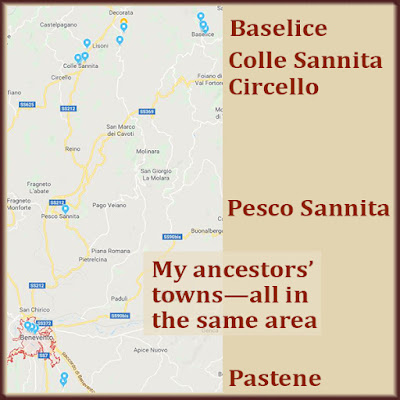Put that person's facts down! You don't know where they came from.
I'll never forget the time someone took my grandfather and added him to their family tree. They didn't care that my grandfather was born in a different town and province than their family. They weren't concerned that his last name—Leone—is practically the Smith of Italy. They just took him and my grandmother!
That's actually one reason why I started this blog. I want us all to be more professional in our genealogy hobby. Do your research with care and skill, and your family tree won't be riddled with non-relatives.
I'll admit I've been guilty of accidentally adding non-relatives to my family tree. It tends to happen when I'm way out on a limb, gathering facts for a 3rd cousin's husband's mother's family. When you get into that level of not-my-people territory, you have no family lore and memories to guide you.
It's too easy to add a man with the right name and the right hometown—even though you haven't proven he's the right guy.
To avoid adding the wrong people to your family tree, set these unbreakable ground rules.
 |
| Shaky leaf hints for my grandmother revealed trees that copied from me before I had the facts right. |
#1 Find the Documentation Yourself
A shaky leaf or someone else's tree is nothing but a lead. Promise yourself you will look at the hint or tree, jot down the facts, and seek proof on your own. Find the census forms, ship manifests and draft registration cards yourself. Weigh those documents yourself. Decide if the person belongs in your family tree for yourself.
Remember: The person whose tree you're looking at may be newer to genealogy than you are.
#2 Don't Ignore Contradictory Information
Let's say you found a woman named Mary Bianco in someone else's tree as a search result. Some of her facts match the Bianco family in your tree. She has the right last name, her father has the right first name, and she lives in the right town.
Is that enough to add her? No, it isn't. Examine all the facts about her.
- Does she have the right first name, or is it a variation of what you expected?
- Does her mother's name match the family you have?
- Are her siblings' names right?
- Is she the right age?
- Was she born in the right place?
If some of her facts don't match the family you want to add her to, stop a moment. You need to prove or disprove her relationship to your family with more research.
Can you find her in other documents? Let's say you have her with a Bianco family in the 1900 census. But her mother's name seems wrong.
Search for this family with the wrong mother in another census year. You may find this is a different family than yours. They have similarities, but other documents prove they're the wrong family. Not your family.
You just saved yourself from making a big mistake.
#3 Make Note of Your Sources
 |
| If you're using an unofficial source, make careful notes! |
You may decide you totally believe someone else's tree. You recognize the author's name. The woman you're researching is the tree owner's grandmother. You really want to add "Mary Bianco" to your tree.
If you're feeling confident enough to add her, add the source to your tree, too. Note that these facts came from "The Bianco Family Tree". Capture the URL of the tree.
If Mary Bianco is important to you, someday you may add better, stronger sources for her name, birth and other facts.
Imagine for a moment that you hired a professional genealogist. Would you still want to pay his fee if one of his sources was "Mary Bianco's granddaughter's tree"?
Allow me to harp on one of my favorite themes again. Your family tree is your legacy. Make it as valuable as possible!




